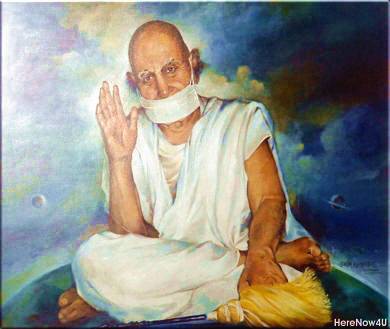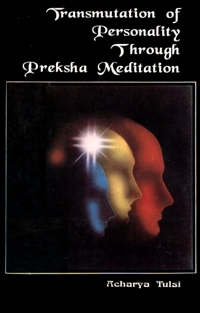
Why in the Middle Ages did obstacles arise
That made the crop of meditation untimely wither?
How it blossomed anew in congenial atmosphere
When irrigated with devotion’s water pure!
Dhyana-Yoga reassessed right and proper;
A technique evolved with labour; now the path's clear.
In Jain philosophy an important tradition of meditation was in vogue. Lord Mahavir was the living symbol of that tradition. In his time hundreds of munis were its eminent practitioners. The successor acharyas and munis further developed this tradition. How then, did this pure tradition get discontinued? What obstructed it?
The even flow of the tradition of meditation was certainly obstructed. But before going into the causes of obstruction, we must take note that even many Jains today do not know that meditation had once an important place in their tradition. Until that is clear, the question of going into the causes of obstruction does not arise. Because if a tradition never existed before, how could it be impeded? We must first of all clearly establish that a technique of dhyana did flourish in the Jain tradition. Then we could go on to discuss the obstructions met with.
For a proper appreciation of these obstacles, we shall have to take a journey into the past. Because, without understanding the context, no historical tradition, its rise or decay, could be justly evaluated.
The roots of the Jain tradition of meditation are found in the Agamas. In the traditional system, dharmya-dhyana and shukla-dhyana have been considered to be very beneficial from the religious point of view. For centuries, the importance of these fundamental modes was highly estimated. "Dhyana Shatak", composed during the 7-8th century is a representative document of this ancient tradition. Later, Patanjali expounded the "Ashtanga-Yoga" which combined the elements of pranayama, asanas, dharana and samadhi, etc. with dhyana. Also during this period, spells and incantations spread extensively. All this could not but affect the tradition of dhyana prevalent at that time. A study of the books written by Acharyas Haribhadra, Somdev, Shubhchandra, Hemchandra, etc. and all other volumes influenced by Yoga-Darshan and Hatha-Yoga, reveals that the Jain acharyas tried to adopt the preponderant tradition of Hatha-Yoga. In the course of these efforts, the ancient tradition of meditation, which was the tradition of dharmya-dhyana and shukla dhyana, was subordinated and its practice abandoned. Their place was taken by pranayama, etc. Because of this people came to believe that the Jains had no independent meditation-system of their own.
At that time, the tradition of pure dhyana, though mixed with other elements, was not altogether discontinued. Later, some community problems arose. The very existence of the Dharma-Sangh was at stake. Public entertainment and the point of view of the public assemblies dominated the scene. Spells and incantations and miraculous tantric experiments, held sway over the minds of the people. Under these circumstances, enchantments and magical practices were avidly sought and the Jain tradition of moral conduct languished. This created obstructions in the way of meditation.
Do we then hold that the tradition of meditation was altogether lost? Or have there been some acharyas and munis who, having brought about a revolution in the field of conduct, reappraised the practice of meditation?
Moral revolutions have been taking place in Jain culture from time to time. These laid sufficient stress on moral conduct, but the practice of meditation still remained secondary. At that time, the tradition of japa had become widespread, and the practice of dhyana was restricted only to a few. The important names in the development of the tradition of meditation are:
- Acharya Anandaghan,
- Acharya Chidanand,
- Acharya Bhikshu
- Jayacharya.
Although in their time, too, the practice of meditation was not very comprehensive, but it did exist, and the tradition of dhyana continued uninterrupted. During the last century, the practice of meditation was somewhat neglected, but the last two or three decades witnessed a revival. During this period, new techniques were evolved and various exercises performed. Jain sadhus and sadhvis and shravaks, convinced that no recognised system of meditation was available to them, began to look around and were attracted by contemporary exercises. Also a new practice of studying ancient scriptures gained ground:
The study of the old books revealed that although dhyana-sadhana was a perennial topic of discussion therein, but no practical work was being done. It was however clear that a definite tradition of meditation did exist among the Jains.
Time, place, situation and mood were all favourable. Conditions were ripe, and time in league with them, and the idea was born of reuniting the threads of tradition that had been cut off. The work of Agama-research was on. In this connection, Uttaradhyayan Agama was in the process of being edited. We had before us many volumes relating to the Swetambar and Digambar traditions. A study of these revealed that diverse elements of dhyana lay scattered in the Jain Agamas. This aroused our interest and a direction was given to Muni Nathmalji [now Acharya Mahaprajna] that the ancient tradition of meditation in Jainism should be re-discovered and the disjointed elements organised into a cohesive whole, and a technique evolved for the use of the present generation.
During the Udaipur chaturmas in 2019 (Vikram Era) [1962 C.E.] work in this direction was started. In the first place, the fundamental elements of dhyana were sought in the Agamas. Later, a programme of practice and experimentation ensued. During the course of these experiments, new curiosities were aroused and resolved and through constant effort, the steadfast resolve matured.
After 15 years uninterrupted labour, we established a forgotten technique, which revivified for us the ancient tradition. We did not have to start from scratch. Our task was to appraise and assess. In the absence of right estimation, even a most useful element lies buried into the folds of time, but after its proper evaluation, it becomes the centre of people's attention. Out of assessment, a new vision evolved, leading to greater understanding. Thereupon our resolve to uncover and bring to light the system of meditation once prevalent in the Jain tradition was all the more strengthened and at last our efforts were crowned with success.
 Acharya Tulsi
Acharya Tulsi
